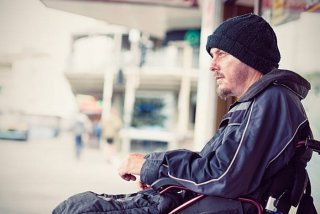Climate Change and the Health of People with Disabilities
The term “disability” covers a wide range of conditions that limit a person’s ability to do certain activities. There are many types of disabilities, including those that affect vision, hearing, speech, cognition, and mobility.1
In 2023, there were more than 44 million U.S. adults living with a disability.2 People with disabilities may be more vulnerable to climate change than the general population because:

- Decisionmakers may not fully consider people with disabilities in their planning. One reason for this is that climate change effects on people with disabilities have not been studied as much as other vulnerable populations.3
- Emergency warnings and other important messages may not be designed with accessibility in mind. This can make it difficult for people with disabilities (such as those with low vision or blindness, hearing loss, or mobility issues) to plan for extreme weather events.4
- They may need ongoing medical care, which can be disrupted before, during, and after a natural disaster or extreme weather event.
- People with disabilities are more likely to have social and economic risk factors, such as poverty and unemployment, that put them at greater risk.5
Key Threats to People with Disabilities’ Health

In the United States, many climate-related threats affect the health of people with disabilities. Below are some examples of the potential health impacts of these hazards.
Heat Illnesses
Heat illnesses can occur when a person is exposed to high temperatures and their body cannot cool down. Increases in average and extreme temperatures and heat waves are expected to lead to more heat illnesses and deaths among vulnerable groups, including people with disabilities.9 Some people with disabilities are especially at risk for heat-related illness and death. These include individuals with mental health issues, those who depend on others for assistance in daily living, and those with limited mobility or access to transportation.10

Social factors can further compound this risk. For example, people with limited incomes may not be able to afford air conditioning in their home during heat waves, increasing their risk of heat stroke.11 Also, people with certain disabilities may not be adequately warned of an extreme heat hazard or what to do to stay safe. For example, important alerts are not always issued in ways that people with hearing or vision loss or blindness can receive or understand them.12
Water-Related Illnesses
Climate change will impact water resources in many ways. For example, changes in water and air temperatures, heavier and longer rains, flooding, and rising sea levels can introduce disease-carrying organisms into drinking water supplies and recreational waters.13 Drinking or coming in contact with untreated contaminated water can cause gastrointestinal illnesses and other health impacts.14 Emergency information (such as a warning to boil contaminated water) may not reach individuals who have hearing loss, are blind or have low vision, or have cognitive disabilities.15
Some people with disabilities may be part of other groups vulnerable to climate change. This can increase their health risks. For example, childhood disability has been rising in recent years, with the rates highest among American Indian and Alaska Native children and those living in poverty.7
Mental Health Effects

As the climate changes, some extreme weather events (such as heat waves, flooding, and droughts) are becoming more frequent and/or more intense.16 These events can cause stress, depression, grief, or anxiety, which can affect people’s well-being and ability to function.17 People with disabilities are among the groups most vulnerable to mental health effects as the climate changes.
Injuries and Death
An increase in extreme weather can especially impact people with disabilities unless communities have a plan to assist these individuals before, during, and after an event. For example, without enough preparation, people with disabilities may not be able to evacuate safely. This can put them at greater risk of injury or death. In addition, power outages from an extreme event can affect medical equipment (such as portable oxygen) operation that many people with disabilities rely upon.18
People with disabilities, as well as their families, loved ones, and caretakers, can take steps to reduce the health impacts of climate change. Consider the following action items:
- Create a support network. Stay connected to your local community before, during, and after an extreme weather event. If possible, reach out to family, friends, neighbors, or caretakers ahead of time, and update them on your whereabouts during an extreme event.
- Prepare for an emergency. Have an emergency plan ready and a kit with medication, food, water, first-aid supplies, and copies of medical records.
- Get help locally. Many local emergency management offices have disability registries, and can assist during an extreme event. These offices can also coordinate transportation if you need to evacuate.
- Stay informed about air quality. Use AirNow to check local air pollution levels and make informed choices about outdoor activities and possible health impacts.
- Check in with friends and family. Ask staff in assisted living facilities if they have emergency supplies, a plan for shelter, and transportation during heat waves, storms, and other extreme weather events.
Related Resources
EPA resources:
Other resources:
Endnotes
1 Gamble, J.L., et al. (2016). Ch. 9: Populations of concern. In: The impacts of climate change on human health in the United States: A scientific assessment. U.S. Global Change Research Program, Washington, DC, p. 260.
2 U.S. Census Bureau. (2024). 2023: American community study. Disability characteristics. Retrieved 11/6/2024.
3 Gamble, J.L., et al. (2016). Ch. 9: Populations of concern. In: The impacts of climate change on human health in the United States: A scientific assessment. U.S. Global Change Research Program, Washington, DC, p. 260.
4 Gamble, J.L., et al. (2016). Ch. 9: Populations of concern. In: The impacts of climate change on human health in the United States: A scientific assessment. U.S. Global Change Research Program, Washington, DC, p. 260.
5 Gamble, J.L., et al. (2016). Ch. 9: Populations of concern. In: The impacts of climate change on human health in the United States: A scientific assessment. U.S. Global Change Research Program, Washington, DC, p. 260.
6 U.S. Bureau of Labor Statistics. (2024). Economic news release. Persons with a disability: Labor force characteristics summary. USDL-24-0349.
7 Young, N. (2021). Childhood disability in the United States: 2019: American community survey briefs (pdf) (749 KB). U.S. Census Bureau. ACSBR-006.
8 U.S. Census Bureau. (2024). 2023: American community study. Disability characteristics. Retrieved 11/6/2024.
9 Crimmins, A., et al. (2016). Executive summary (pdf) (5 MB). In: The impacts of climate change on human health in the United States: A scientific assessment. U.S. Global Change Research Program, Washington, DC, p. 6.
10 Gamble, J.L., et al. (2016). Ch. 9: Populations of concern. In: The impacts of climate change on human health in the United States: A scientific assessment. U.S. Global Change Research Program, Washington, DC, p. 258.
11 Gamble, J.L., et al. (2016). Ch. 9: Populations of concern. In: The impacts of climate change on human health in the United States: A scientific assessment. U.S. Global Change Research Program, Washington, DC, p. 252.
12 Gamble, J.L., et al. (2016). Ch. 9: Populations of concern. In: The impacts of climate change on human health in the United States: A scientific assessment. U.S. Global Change Research Program, Washington, DC, pp. 258–260.
13 Trtanj, J., et al. (2016). Ch. 6: Climate impacts on water-related illness. In: The impacts of climate change on human health in the United States: A scientific assessment. U.S. Global Change Research Program, Washington, DC, p. 159.
14 Trtanj, J., et al. (2016). Ch. 6: Climate impacts on water-related illness. In: The impacts of climate change on human health in the United States: A scientific assessment. U.S. Global Change Research Program, Washington, DC, p. 165.
15 Gamble, J.L., et al. (2016). Ch. 9: Populations of concern. In: The impacts of climate change on human health in the United States: A scientific assessment. U.S. Global Change Research Program, Washington, DC, p. 260.
16 Intergovernmental Panel on Climate Change (IPCC). (2021). Chapter 11: Weather and Climate Extreme Events in a Changing Climate. In: Climate change 2021: The physical science basis. Contribution of Working Group 1 to the Sixth Assessment Report of the Intergovernmental Panel on Climate Change. Cambridge University Press.
17 Dodgen, D., et al. (2016). Ch. 8: Mental health and well-being. In: The impacts of climate change on human health in the United States: A scientific assessment. U.S. Global Change Research Program, Washington, DC, p. 220.
18 Gamble, J.L., et al. (2016). Ch. 9: Populations of concern. In: The impacts of climate change on human health in the United States: A scientific assessment. U.S. Global Change Research Program, Washington, DC, p. 260.
